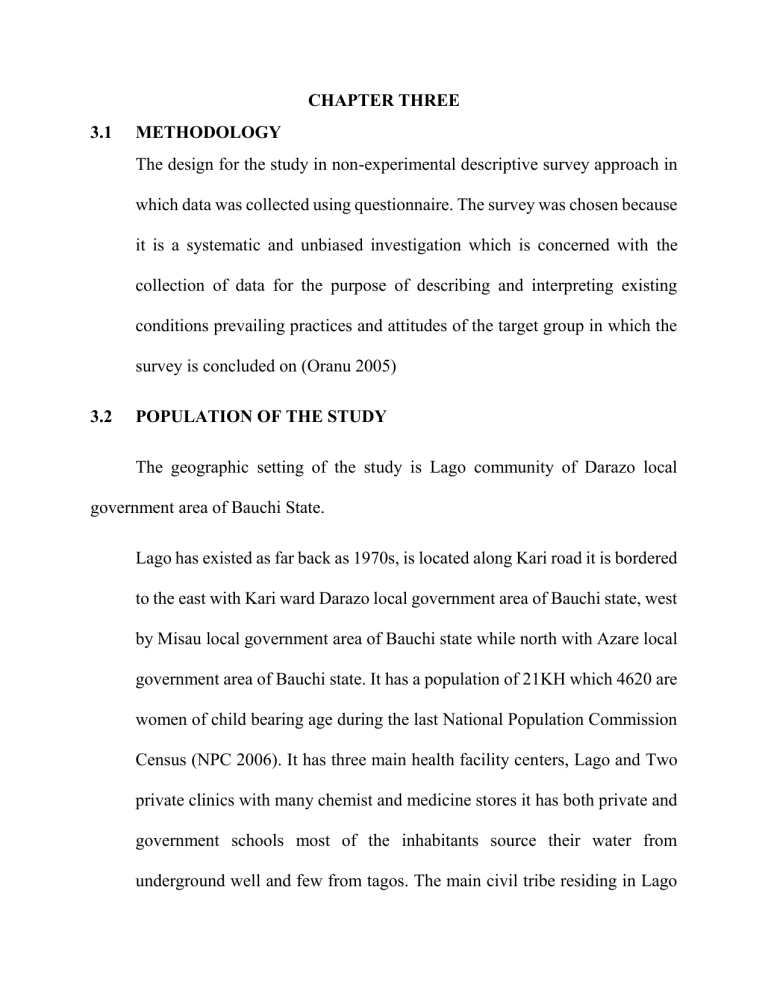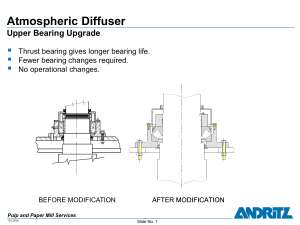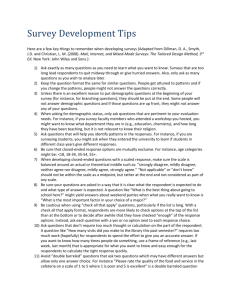
CHAPTER THREE 3.1 METHODOLOGY The design for the study in non-experimental descriptive survey approach in which data was collected using questionnaire. The survey was chosen because it is a systematic and unbiased investigation which is concerned with the collection of data for the purpose of describing and interpreting existing conditions prevailing practices and attitudes of the target group in which the survey is concluded on (Oranu 2005) 3.2 POPULATION OF THE STUDY The geographic setting of the study is Lago community of Darazo local government area of Bauchi State. Lago has existed as far back as 1970s, is located along Kari road it is bordered to the east with Kari ward Darazo local government area of Bauchi state, west by Misau local government area of Bauchi state while north with Azare local government area of Bauchi state. It has a population of 21KH which 4620 are women of child bearing age during the last National Population Commission Census (NPC 2006). It has three main health facility centers, Lago and Two private clinics with many chemist and medicine stores it has both private and government schools most of the inhabitants source their water from underground well and few from tagos. The main civil tribe residing in Lago are Gbagyi; they are mainly civil servants, business men and women and farmers. The target population involves women of child bearing age. The number of child bearing women Lago community is about 4620 by National Population Commission Census 2006). 3.3 SAMPLE AND SAMPLING TECHNIQUES In order to collect data fro the achievement of optimum success in the study simple random sampling by ballating is to employ to represent the whole population. Therefore, a ample size of 101 women of child bearing age which is 10% percent of the target population were selected (Nwabuake, 2002). 3.4 INSTRUMENT FOR DATA COLLECTION The instrument to be used for the questionnaire consists of two section “A” and “B”, section “A” comprises of demographic/personal data while section “B” consist of list of questions the questionnaires used in this study is four point scales, this was distributed by the researcher to the respondent with full explanation. This is because is gives room for the respondent to fell free in answering confidential questions which she could otherwise decline answering if a researcher is to be with her. It is also ways to administer analyze and employ quick method of collection of data and avoiding unnecessary responses from the respondents. It also give the respondent the opportunity ti assess the extent of agreeableness or disagreeableness (Enfuga, 2004). 3.5 PROCEDURE FOR DATA COLLECTION As a standard procedures male moderators conducted (FGDs) with males, where as female moderators conducted (FGDs) with female groups each (FGDs) was audio tape recorded and in addition to audio tape recording filed and observational nates was also taken by research assistance. The procedures of data collection the ECLS-K collected information from children and their parents teachers and schools. Data were collected using a variety of assessments computer assisted telephone pencil questionnaires. According to T.Tilahum, 2013 cited by 77 23rd April, 2013. Data were collected from March to May, fertility preferences and attitudes towards family planning the ethics committees approved this consent procedure. The procedures for the work is (91) structure items questionnaires are divided into two (2) section “A” and section “B” 3.6 METHOD OF DATA ANALYSIS The researcher uses the descriptive statistics these include the use of frequency distribution and percentage to analyze the data so as to able to answer the research questions. The formula use for the percentage is X/yx 100/1 WHERE X = Number of respondents Y = Total number of respondents. CHAPTER FOUR 4.1. RESULT PRESENTATION The following table shows the demographic characteristics of the respondents according to their ages Table 1: Age distribution of the sample of respondents AGE (YEAR) 28-25 26-30 31-35 36-40 TOTAL FREQUENCY 23 40 18 10 91 PERCENTAGE 25% 44% 20% 11% 100% Table 2 Distribution based on occupation OCCUPATION Civil servant Full time Farmers Tracers TOTAL FREQUENCY 25 23 13 20 91 PERCENTAGE 27% 25% 24% 21 100% Table 3: Distribution according to religion RELIGION Islam Christianity Traditional TOTAL FREQUENCY 80 8 3 91 PERCENTAGE 87 9 3 100% Table 4: Distribution based on educational status EDUCATIONAL STATUS Illiterate Primary Non formal education Tertiary institution FREQUENCY 10 49 18 14 PERCENTAGE 11% 53% 20% 15% TOTAL 91 100% Table 5: Mean rating attitude of women of child bearing age to world family planning S/N Attitude Strongly of women agreed of child (SA) bearing toward family planning 1 2 3 4 5 I like family planning service Family planning method are accessible to me Practice family method I feel family planning method are healthier I encourage others to practice family planning Agreed Disagree Strongly No of Mea Remar (A) (DS) Disagree respondent n k (SD) 4 3 2 1 42 27 12 10 91 3.1 Agree d 39 33 11 8 91 3.1 Agree d 22 42 19 8 90 2.1 Agree d 20 41 18 12 91 2.8 Agree d Table 6: Mean rating attitude of women of child bearing age to ward family planning S/N The Strongly possible agreed factors (SA) that could restrict it usage 1 2 3 4 5 There is shortage of available family planning providers Family planning is against my culture and belief Bad attitudes f family planning providers utilization of the service Low income hinders from practicing F/P My religion belief Agreed Disagree Strongly No of Mea Remar (A) (DS) Disagree respondent n k (SD) 19 45 15 50 37 4 14 24 39 41 15 50 37 12 91 2.8 Agree d 91 3.5 Agree d 16 91 3.5 Agree d 12 23 91 2.8 Agree d 3 1 91 3.5 Agree d 6 banned me from family planning Side effect of same family planning method hinders me from family planning 9 12 40 30 91 2.0 Agree d




